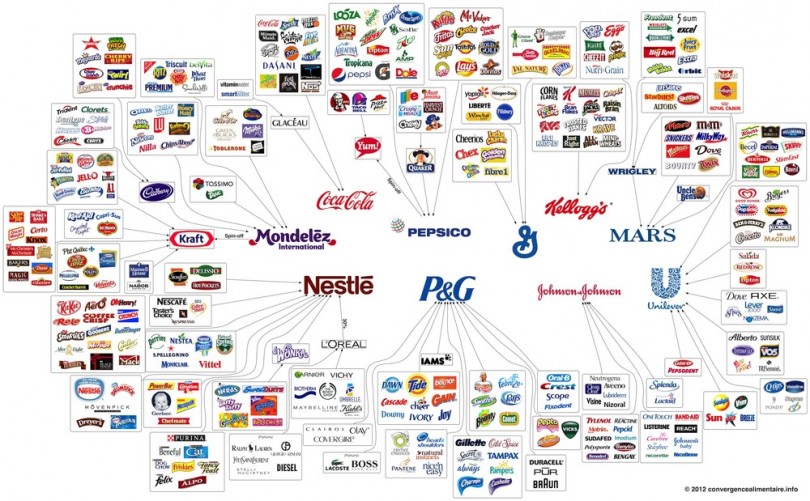aNewDomain.net — There are ten mega corporations that control almost everything you buy. They predict and forcefully guide your shopping experience, from household products to batteries to food. More than that, the big ten and their countless subsidiaries collect data about you and your shopping habits from their stores.
The Ten Mega Companies
According to this chart via Reddit, called “The Illusion of Choice,” these corporations create a chain of supplies that flows endlessly from the center to your hands. Each chain begins at one of the ten super companies. What is choice, really? The process starts in the dressing room. IBM helped German retailer METRO boost customer satisfaction by 18 percent with intelligent dressing rooms that would detect the shopper’s current apparel selection and make appropriate recommendations for accessories. That is way-more invasive than the NSA. The color of your underwear has become metadata. Metadata that helps companies more effectively target and sell to their unsuspecting consumers. The metadata and algorithms created to craft a shopping experience are used heavily on shopping addicts. One in four shopaholics use “Retail Therapy,” a purge through purchase, as a way to pull themselves out of their bad mood. See the stats below.
The Technology
Imagine: You walk into your favorite apparel store. Surveillance cameras mounted on the door immediately detect who you are and beam identifying information to the in-store sales associates. An app on the sales associate’s tablet then correlates all of your shopping characteristics — loyalty, past purchases, cross-channel preferences, service incidents and social expression. A consolidated view is provided to help them make quick decisions. With this information, the sales associate can walk up to you as you enter the store, greet you by name and inquire about your most-recent purchase. This level of personalized attention dramatically alters an individual’s in-store shopping experience. The seamless ease of the above scenario is not that far-fetched. Breakthroughs in new facial-recognition technology combined with real-time analytics can help brick-and-mortar retail storefronts provide greater levels of personalization. Personalization in itself is a very enticing marketing concept. The act, meanwhile, hides incredibly-invasive techniques of which the shopper is not aware, thus altering their mood and decisions. You are not a person but a digitized predictable binary shopper.
- Almax has created “smart mannequins.” These plastic statues have cameras for eyes and analyze shoppers’ faces to detect age, gender, ethnicity and a variety of other characteristics. A luxury-goods retailer is currently piloting Almax’s technology to better assess their marketing messages, potentially discover new target groups and tune their in-store displays.
- NEC has built a similar system called NeoFace that can alert staff when a loyal customer or a big spender walks into a store.
- Kraft has partnered with Intel to create an in-store kiosk that leverages video analytics to assist shoppers with product recommendations based on their physical characteristics and past purchasing history.
The usefulness of location analytics are more prominent than ever:
Retail sites can compare sales territory revenue and assess marketing campaign effectiveness. Businesses can see exactly where customers live to determine where to open stores and distribute products. Government agencies show taxpayers where and how money is spent. Fire fighters get the digital floor plan in their vehicle before they enter a burning house. Hospitals determine demand for new vaccines or make sense of sudden disease outbreaks. This is possible because every information system, desktop solution, or mobile app can take advantage of location. BI, CRM, ERP, or any other acronym you can think of — location analytics fits within them all.”
Read more on location analytics here. You are the naked consumer, and everyone is trying to clothe you. As Eric Schmidt of Google said: “If you don’t have anything to hide, do not be afraid.” How long until your consumer history, your location and your endless preferences are part of the metadata complex? All so someone can predict what color socks you need to buy.
For aNewDomain.net, I’m David Michaelis.
Based in Australia, David Michaelis is a world-renowned international journalist , Peabody award recipient, and founder of Link Tv. At aNewDomain.net, he covers the global beat, focusing on politics and other international topics of note for our readers in a variety of forums. Email him at DavidMc@aNewDomain.net. 
Credit: www.onlinepsycholgy.net















Targeting the “big spender” is a foolish practice as its the millions of “little spenders” that really bolster a companies bottom line.
For the most part, I don’t like shopping. Its boring.
[…] Ten Mega Corporations Predict Your Shopaholic Addictions (infographic) by David Michaelis […]
[…] aNewDomain.net — It’s so frustrating. You see an ad for a certain something that you absolutely must have that’s on sale. It doesn’t matter what it is, but you know you really want it. It could be a certain kind of weatherproof varnish, a wireless adapter, a 50-foot garden hose, or a buy-one-get-one-free deal on catfish fillets. “Great, I gotta get this thing,” you say with absolute enthusiasm. If you do what I do, you put the ad down, and in 10 seconds you forget all about it. A week later, you happen to come across the ad again and say, “Oh yeah, I forgot. I gotta get this thing.” […]